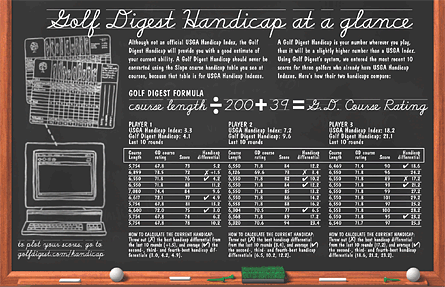Get a Handicap
Simple and free alternative: The Golf Digest Handicap
By Dean Knuth
Golf Digest
August 2003

Illustration: Chris O'Riley
Editor's note: Dean Knuth served as the U.S. Golf Association's senior director of handicapping from 1981 to 1997 and has been a Golf Digest Contributing Editor for the past four years. Knuth developed the formula for the Golf Digest Handicap System outlined in this article at our request.
With this issue Golf Digest is embarking on a campaign to encourage every golfer to get a handicap -- preferably a USGA Handicap Index (www.usga.org/handicap). However, as a simplified alternative, I've developed a system you can access at www.golfdigest.com/handicap that will calculate for you a Golf Digest Handicap you can use until you get a USGA handicap. The Golf Digest System is easy to use, and it'll give you a good estimate of your current ability. The handicap it produces is fair and portable from course to course, and the system will be refined as more golfers sign up and data is collected.
The Golf Digest Handicap System does not use any elements of the USGA Handicap System, aside from the basic premise of allowing golfers of different abilities to compete fairly and equitably against each other. The USGA's Course and Slope Ratings will not be used, because those are the exclusive property of the USGA Handicap System that I developed. The Slope course handicap tables do not apply to Golf Digest Handicaps.
The Golf Digest Handicap is not based on your average play, but on your average "potential" ability, which is consistent with all handicap systems throughout the world.
It's absolutely free to get a Golf Digest Handicap, and all you need to do to get started is visit the Golf Digest Handicap home page at http://handicap.golfdigest.com. Once there, you'll need to register by entering your name and address, and you'll need to create a user name and password. After that, just enter your scores after every round you play, and the system will do the rest for you.
--------------------------------------------------------------------------------
How the Golf Digest handicap system works
� Numbers you need: Even though the website will calculate your Golf Digest Handicap for you, the formula is so simple you can figure it out on your own with a pen and paper. Either way, the only numbers you need are: 1) your scores, adjusted according to the stroke-limit requirements as stipulated below; 2) length of courses from tees you played.
� Stroke limit: For handicap purposes, the Golf Digest Handicap system requires that you never record a score higher than net double bogey on any hole. For example, if a 15-handicap golfer is playing a par-4 hole that's ranked as the No. 12 handicap hole on the scorecard, the maximum score that could be recorded on that hole would be 7 (par plus your handicap stroke equals 5, making net double bogey a 7). Until you've established a handicap, do your best to estimate what net double bogey is foryou on each hole.
� Golf Digest's course rating: Every course you play will earn a Golf Digest course rating based solely on the yardage from the tees you played. The system will calculate each course rating for you by using the following formulas: The 18-hole formula for men is course length divided by 200 plus 39.
For example, if your course is 6,400 yards, the Golf Digest course rating would be 71.0 (6,400 divided by 200 is 32, plus 39 is 71). The nine-hole formula is course length divided by 200 plus 19.5. Round off to the nearest 10th and this will be the Golf Digest course rating for that set of tees. For women, the course rating formula is length divided by 170 plus 39 (and for nine holes, lengthdivided by 170 plus 19.5).
As more and more scores are collected from different courses, Golf Digest will develop a refined course-rating system, based on the collected scores of all golfers who have played and entered their scores.
� Figuring your handicap: To determine your handicap, the system will calculate your differentials from each round and average the second-, third- and fourth-best differentials. A differential is score minus Golf Digest course rating, calculated to the nearest 10th. Also, for the convenience of users, course names and tee information will be stored in the system, so posting will become easier as the database is developed.
� One score gets you started: You will receive a handicap immediately upon your first posting, based on that one score. After you've posted from two to five scores, your handicap will be based on your second-best score. When you have six to nine scores in the system, your handicap will be based on the average of your second- and third-best scores. And after you've posted 10 or more scores, your handicap will be based on the average of your second-, third- and fourth-best differentials of the last 10 rounds played. That average would become your current Golf Digest Handicap. The best score is not used because every golfer should be allowed one great score without it drastically reducing your handicap. That's why the "career round" is thrown out.
The Golf Digest Handicap is based only on your most recent 10 scores. Unlike the USGA's system, which uses the best 10 out of the last 20 scores, the Golf Digest Handicap uses only your most recent 10 scores. This is because studies show that many golfers who don't have handicaps average only 10 rounds a year.
� Nine-hole and 18-hole handicap: Because 40 percent of rounds played in the U.S. are nine holes, you may establish a nine-hole handicap in addition to your 18-hole handicap. You will need to post your score from every round played, whether it's nine holes or 18.
|




